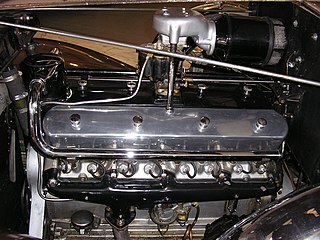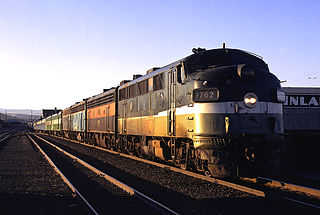
A V16 engine is a sixteen-cylinder piston engine where two banks of eight cylinders are arranged in a V configuration around a common crankshaft. V16 engines are less common than engines with fewer cylinders, such as V8 and V12 engines. Each bank of a V16 engine can be thought of as a straight-eight, a design that can be inherently balanced. Most V16 engines have a 45° bank angle.

The SD80MAC was a 5,000 horsepower (3.7 MW) C-C diesel-electric locomotive. It was powered by a 20-cylinder version of EMD's 710G prime mover, and was the second diesel locomotive by GM-EMD to use a V20 engine, since EMD's SD45 series. It introduced a wide radiator housing similar to GE Transportation locomotives and the placement of dynamic brakes at the rear of the locomotive, which is a quieter location, features that were incorporated into the SD90MAC and SD70ACe models. Key spotting differences between the SD80MAC and SD90MAC include no external rear sandbox on the SD90MAC, no rear lighted number boards on the SD90MAC, and the placement of the front numberboards. The SD80MAC also had recessed red marker lights in the nose, an identifying feature unique to Conrail (CR) locomotives, although Norfolk Southern (NS) had removed the lights on most of their former Conrail engines.

The EMC E3 is a 2,000 horsepower (1,500 kW), A1A-A1A passenger train locomotive that was manufactured by Electro-Motive Corporation of La Grange, Illinois. The EMC demonstrator #822 was released from La Grange for test on September 12, 1938. The cab version, or E3A, was manufactured from September 1938 to June 1940, and 17 were produced. The booster version, or E3B, was manufactured in March 1939 and September 1939, and 2 were produced. The 2,000 hp (1,500 kW) was achieved by putting two 1,000 horsepower (750 kW), 12-cylinder, model 567 engines in the engine compartment. Each engine drove its own electrical generator to power the traction motors. The E3 was the fourth model in a long line of passenger diesels of similar design known as EMD E-units.

The ALCO RS-3 is a 1,600 hp (1.2 MW), B-B diesel-electric locomotive manufactured from May 1950 to August 1956 by American Locomotive Company (ALCO) and its subsidiary Montreal Locomotive Works (MLW). A total of 1,418 were produced: 1,265 for American railroads, 98 for Canadian railroads, 48 for Brazilian railroads, and seven for Mexican railroads.

EMD E-units were a line of passenger train streamliner diesel locomotives built by the General Motors Electro-Motive Division (EMD) and its predecessor the Electro-Motive Corporation (EMC). Final assembly for all E-units was in La Grange, Illinois. Production ran from May 1937, to December, 1963. The name E-units refers to the model numbers given to each successive type, which all began with E. The E originally stood for eighteen hundred horsepower, the power of the earliest model, but the letter was kept for later models of higher power.

EMD F-units are a line of diesel-electric locomotives produced between November 1939 and November 1960 by General Motors Electro-Motive Division and General Motors-Diesel Division. Final assembly for all F-units was at the GM-EMD plant at La Grange, Illinois, and the GMDD plant in London, Ontario. They were sold to railroads throughout the United States, Canada and Mexico, and a few were exported to Saudi Arabia. The term F-unit refers to the model numbers given to each successive type, all of which began with the letter F. The F originally meant "fourteen", as in 1,400 horsepower (1,000 kW), not "freight". Longer EMD E-units for passenger service had twin 900-horsepower (670 kW) diesel engines. The E meant "eighteen" as in 1,800 horsepower (1,300 kW). Similarly, for early model EMD switchers, S meant "six hundred" and N meant "nine hundred horsepower".

The EMD F3 is a 1,500-horsepower (1,100 kW) B-B freight- and passenger-hauling carbody diesel locomotive produced between July 1945 and February 1949 by General Motors’ Electro-Motive Division. Final assembly was at GM-EMD's La Grange, Illinois plant. A total of 1,111 cab-equipped lead A units and 696 cabless booster B units were built.

The EMD F7 is a model of 1,500-horsepower (1,100 kW) diesel-electric locomotive produced between February 1949 and December 1953 by the Electro-Motive Division of General Motors (EMD) and General Motors Diesel (GMD).

The EMD F9 is a 1,750 horsepower (1,300 kW) Diesel-electric locomotive produced between February 1953 and May 1960 by the Electro-Motive Division of General Motors (EMD) and General Motors Diesel (GMD). It succeeded the F7 model in GM-EMD's F-unit sequence. Final assembly was at GM-EMD's La Grange, Illinois plant. The F9 was also built in Canada by General Motors Diesel at their London, Ontario plant. A total of 101 cab-equipped lead A units and 156 cabless booster B units were built. The F9 was the fifth model in GM-EMD's highly successful "F" series of cab unit diesel locomotives.

The EMD SW9 is a model of diesel switcher locomotives built by General Motors Electro-Motive Division between November 1950 and December 1953. Additional SW9s were built by General Motors Diesel in Ontario Canada from December 1950 to March 1953. Power was provided by an EMD 567B 12-cylinder engine, producing 1,200 horsepower (895 kW).

The EMD GP9 is a four-axle diesel-electric locomotive built by General Motors' Electro-Motive Division between 1954 and 1959. The GP9 succeeded the GP7 as the second model of EMD's General Purpose (GP) line, incorporating a new sixteen-cylinder engine which generated 1,750 horsepower (1.30 MW). This locomotive type was offered both with and without control cabs; locomotives built without control cabs were called GP9B locomotives.

The EMD GP18 is a 4-axle diesel-electric locomotive built by General Motors, Electro-Motive Division between December 1959 and November 1963. Power was provided by an 16-567D1 16-cylinder engine which generated 1,800 horsepower (1.34 MW). The GP18 replaced the GP9 in EMD's catalog. 350 examples of this locomotive model were built for American railroads, 40 units were built for Mexican railroads, 12 were built for export to a Brazilian railroad, 2 were exported to Peru, and 1 was exported to Saudi Arabia.

The EMD GP39 is a 4-axle diesel-electric locomotive built by General Motors Electro-Motive Division between June 1969 and July 1970. The GP39 was a derivative of the GP38 equipped with a turbocharged EMD 645E3 12-cylinder engine which generated 2,300 hp (1.72 MW).

The EMD SD38 is a 6-axle diesel-electric locomotive built by General Motors Electro-Motive Division between May 1967 and October 1971. It had an EMD 645 16-cylinder engine generating 2,000 horsepower (1.5 MW), compared to the turbocharged EMD 645E3 V-16 engine that produced 3000 horsepower. Aside from the 3-axle trucks and a longer frame to accommodate them, the SD38 was identical to the GP38; the SD38 had the same frame as the SD39, SD40 and SD45. 52 were built for American railroads, one was built for a Canadian railroad, four were exported to a mining firm in Jamaica and seven were exported to a mining firm in Venezuela. The SD38 was succeeded by a Dash 2 version called the EMD SD38-2.

The EMD SD40 is an American 6-axle diesel-electric locomotive built by General Motors Electro-Motive Division between January 1966 and August 1972. 1,268 locomotives were built between 1966 and 1972. In 1972, an improved version with new electronics was developed and marketed as a new locomotive, the SD40-2.

An SDP40 is a 6-axle passenger diesel-electric locomotive built by General Motors Electro-Motive Division (EMD) between June 1966 and May 1970.

The SD39 is a model of 6-axle diesel-electric locomotive built by General Motors Electro-Motive Division between August 1968 and May 1970. 54 were built for American railroads.

The EMD 567 is a line of large medium-speed diesel engines built by General Motors' Electro-Motive Division. This engine, which succeeded Winton's 201A, was used in EMD's locomotives from 1938 until its replacement in 1966 by the EMD 645. It has a bore of 8+1⁄2 in (216 mm), a stroke of 10 in (254 mm) and a displacement of 567 cu in (9.29 L) per cylinder. Like the Winton 201A, the EMD 645 and the EMD 710, the EMD 567 is a two-stroke engine.

The EMD 710 is a line of diesel engines built by Electro-Motive Diesel. The 710 series replaced the earlier EMD 645 series when the 645F series proved to be unreliable in the early 1980s 50-series locomotives which featured a maximum engine speed of 950 rpm. The EMD 710 is a relatively large medium-speed two-stroke diesel engine that has 710 cubic inches displacement per cylinder, and a maximum engine speed of 900 rpm.

The Indian locomotive class WDG-5 is a class of heavy haul Diesel-electric locomotive built by Banaras Locomotive Works, Varanasi in collaboration with Electro-Motive Diesel. At a rated power output of 5,500 horsepower (4,100 kW), it is the second most powerful diesel locomotive class on Indian Railways, just out-powered by the 6,000 horsepower (4,500 kW) WDG-6G. Derived from the EMD SD80MAC, it was meant as a direct upgrade to the WDG-4 aka GT46MAC. The locomotive series is named Bheem, after the strong Pandav brother from epic Mahabharata. The loco has the 2-stroke Turbocharged EMD 20N-710G3B-ES of the EMD SD80MAC and an AC-AC transmission. Since the loco has been developed by installing a v20-710 prime mover and replacing the standard v16 in the WDG4 GT46MAC locomotive, the model was re-designated by adding 4 to the predecessor model, with GT-46 becoming GT-50, owing to the number of cylinders going from 16 to 20, thereby making it the First EMD locomotive in the GT-series to use a v20-710 engine.




















